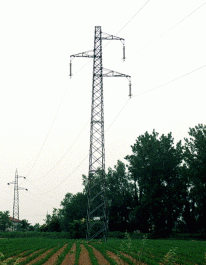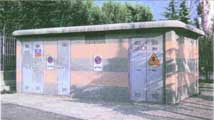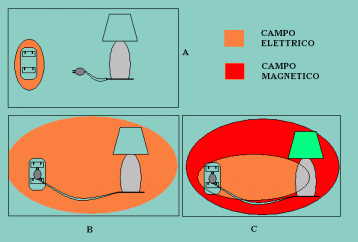Natural and artificial electromagnetic radiations
There are several wave
classifications, with various details and references to their physical
properties.
Here we
mention only the two most common ones:
- Alternating currents,
radiofrequencies
 ,
microwaves
,
microwaves ,
infrared
,
infrared ,
visible
,
visible , near
ultraviolet
, near
ultraviolet (UVA): a
classification which underlines the evolution of the respective applications.
(UVA): a
classification which underlines the evolution of the respective applications.
-
ELF
 (extremely low frequency),VF (voice frequency),
VLF (very low frequency),
LF (low frequency),
RF (radiofrequency) and MW (microwaves): a
classification into precisely defined frequency bands, from
almost-static-fields (ELF) up to microwaves (MW).
(extremely low frequency),VF (voice frequency),
VLF (very low frequency),
LF (low frequency),
RF (radiofrequency) and MW (microwaves): a
classification into precisely defined frequency bands, from
almost-static-fields (ELF) up to microwaves (MW).
|
|
|
In the ELF we find all the common
alternating currents now used: 50 Hz in Europe, 60 Hz in the USA, Japan and few
other countries. The best known sources are: long-distance power lines (fig.1),
electric stations and transforming cabins (fig. 2 and 3) and electric household
appliances, in general. Compared to man's size, their
wave length![]() is so big that
the two fields,
electric
is so big that
the two fields,
electric![]() and
magnetic
and
magnetic![]() , must be considered as two
independent magnitudes (near electromagnetic field
, must be considered as two
independent magnitudes (near electromagnetic field![]() ).
).
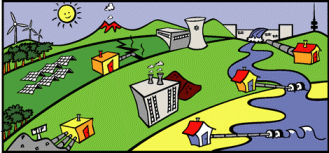 |
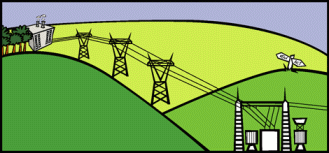 |
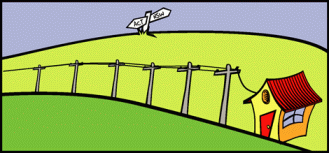 |
Fig. 3:
Drawings showing, in order: production, transmission and distribution of
electric energy. (Credit: ActewAGL's Education Website) |
An electric field on an unshielded person discharges to ground, while the magnetic field "permeates" the body inducing a magnetic flux that generates secondary electric fields inside the body (fig. 4).
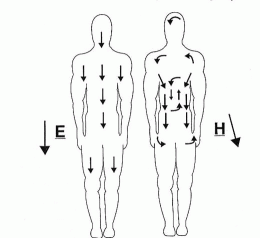 |
|
| Fig. 4:
Electric
E (Credit: Paolo Bevitori, "L'inquinamento elettromagnetico quotidiano", Macro Edizioni) |
It is well known that the earth, buildings, trees and other materials interposed with the electromagnetic source may shield the electric field, but not the magnetic one . (If not properly studied, even the burying of power lines could simply be a way of hiding the problem instead of solving it!).
The situation must be considered as
indoor![]() and
outdoor
and
outdoor![]() ;
exposure values inside and outside
buildings and the respective
lengths of time spent there,
in particular exposures are referred to operators or to the population at large. Inside a typical house
the electric field is usually of 100 times lower than the one outside. The magnetic
field, instead, does not change and it attenuates only according to the effective
moving away from the source. In a normal
house there are also many "internal" sources in the form of the various "running electric appliances" and whatever is
connected to the electric current (fig.5). (On average, the
magnetic induction
;
exposure values inside and outside
buildings and the respective
lengths of time spent there,
in particular exposures are referred to operators or to the population at large. Inside a typical house
the electric field is usually of 100 times lower than the one outside. The magnetic
field, instead, does not change and it attenuates only according to the effective
moving away from the source. In a normal
house there are also many "internal" sources in the form of the various "running electric appliances" and whatever is
connected to the electric current (fig.5). (On average, the
magnetic induction![]() , (the magnetic flux), inside houses in developed countries
is not higher than 0.1
micro
, (the magnetic flux), inside houses in developed countries
is not higher than 0.1
micro![]() tesla
tesla![]() ,
but in particular spots it may reach
and exceed 100 microtesla. For such values
health
risks
,
but in particular spots it may reach
and exceed 100 microtesla. For such values
health
risks![]() are not yet demonstrated).
are not yet demonstrated).
|
|
| Fig. 5: The
electrical field is always present in domestic areas, whether or not appliances are switched on. Instead the magnetic field is produced only when the
appliances are working. (Credit: Arpa Veneto) |
Questions concerning higher frequencies than ELF (i.e. radio-frequencies and microwaves) will be discussed in the next section.
